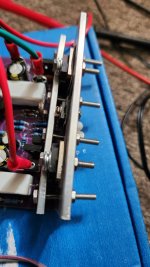I decided to use a screw and nut as the aluminium I've got is really soft. I had an idea come to mind with copper plates to speed up thermal tracking and hopefully make it a bit easier to mount the transistors which would help with shortening leg length as I want to really pack these amps into an amp sandwich.
I'll see how I go. I've taken your feedback on board and will have a look.
I'll see how I go. I've taken your feedback on board and will have a look.
I've done more experiments and the vbe servo does not appear to be working in the first place. Chucked in on a copper plate and it still goes thermal runaway even with good transfer to the copper plate. Mind you it does need a signal to get it going into such a state. There may be something wrong with the VBE servo transistor or I didn't correctly set it up?
If you don't have one already, a cheap digital oscilloscope could help you figure out what's going on. It still sounds like some sort of oscillation problem. Where are C8 and C9 located?
That's not my definition of elegance in circuit design 🙂Bulkier and more expensive but more elegant, I think.
Well, I guess elegance is in the eye of the beholder. A low voltage polar cap that could see rail voltage of either sign under fault so we put diodes across it to protect it, and all that just to save a few pennies... More elegant to you, less elegant to me. And yes, I realize in a commercial context (which is Self's background and it often shows) those pennies add up when you're mass producing, but this is DIY, no?
Attachments
Nvm vas and ccs are insanely hot which is what has probably driven the output stage current to heck. Gonna drop vas current and see what happens.
- Home
- Design & Build
- Electronic Design
- Output stage completely blown during idle conditions
